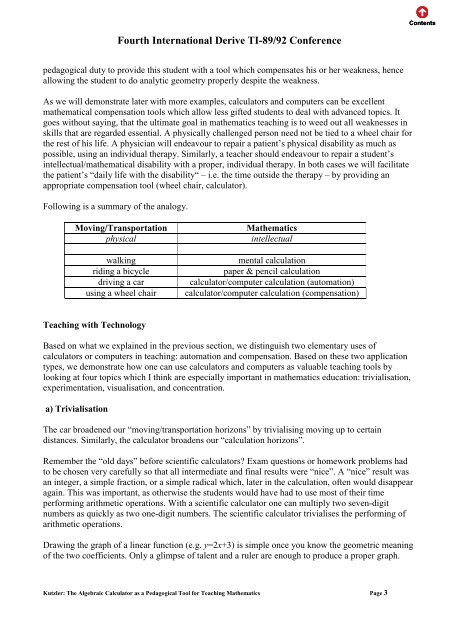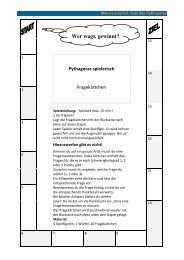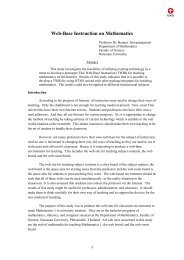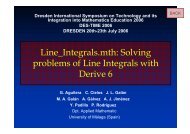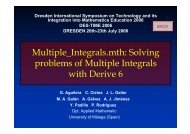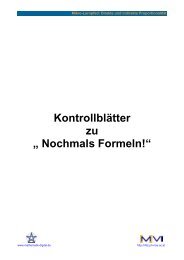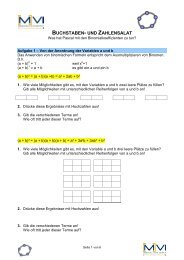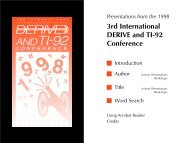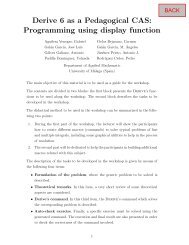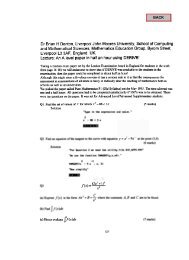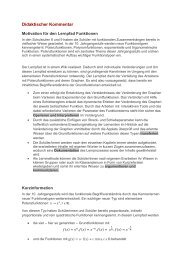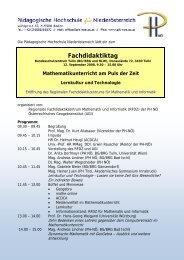The Algebraic Calculator as a Pedagogical Tool for Teaching ...
The Algebraic Calculator as a Pedagogical Tool for Teaching ...
The Algebraic Calculator as a Pedagogical Tool for Teaching ...
Create successful ePaper yourself
Turn your PDF publications into a flip-book with our unique Google optimized e-Paper software.
Fourth International Derive TI-89/92 Conference<br />
pedagogical duty to provide this student with a tool which compensates his or her weakness, hence<br />
allowing the student to do analytic geometry properly despite the weakness.<br />
As we will demonstrate later with more examples, calculators and computers can be excellent<br />
mathematical compensation tools which allow less gifted students to deal with advanced topics. It<br />
goes without saying, that the ultimate goal in mathematics teaching is to weed out all weaknesses in<br />
skills that are regarded essential. A physically challenged person need not be tied to a wheel chair <strong>for</strong><br />
the rest of his life. A physician will endeavour to repair a patient’s physical disability <strong>as</strong> much <strong>as</strong><br />
possible, using an individual therapy. Similarly, a teacher should endeavour to repair a student’s<br />
intellectual/mathematical disability with a proper, individual therapy. In both c<strong>as</strong>es we will facilitate<br />
the patient’s “daily life with the disability“ – i.e. the time outside the therapy – by providing an<br />
appropriate compensation tool (wheel chair, calculator).<br />
Following is a summary of the analogy.<br />
Moving/Transportation Mathematics<br />
physical intellectual<br />
walking mental calculation<br />
riding a bicycle paper & pencil calculation<br />
driving a car calculator/computer calculation (automation)<br />
using a wheel chair calculator/computer calculation (compensation)<br />
<strong>Teaching</strong> with Technology<br />
B<strong>as</strong>ed on what we explained in the previous section, we distinguish two elementary uses of<br />
calculators or computers in teaching: automation and compensation. B<strong>as</strong>ed on these two application<br />
types, we demonstrate how one can use calculators and computers <strong>as</strong> valuable teaching tools by<br />
looking at four topics which I think are especially important in mathematics education: trivialisation,<br />
experimentation, visualisation, and concentration.<br />
a) Trivialisation<br />
<strong>The</strong> car broadened our “moving/transportation horizons” by trivialising moving up to certain<br />
distances. Similarly, the calculator broadens our “calculation horizons”.<br />
Remember the “old days” be<strong>for</strong>e scientific calculators? Exam questions or homework problems had<br />
to be chosen very carefully so that all intermediate and final results were “nice”. A “nice” result w<strong>as</strong><br />
an integer, a simple fraction, or a simple radical which, later in the calculation, often would disappear<br />
again. This w<strong>as</strong> important, <strong>as</strong> otherwise the students would have had to use most of their time<br />
per<strong>for</strong>ming arithmetic operations. With a scientific calculator one can multiply two seven-digit<br />
numbers <strong>as</strong> quickly <strong>as</strong> two one-digit numbers. <strong>The</strong> scientific calculator trivialises the per<strong>for</strong>ming of<br />
arithmetic operations.<br />
Drawing the graph of a linear function (e.g. y=2x+3) is simple once you know the geometric meaning<br />
of the two coefficients. Only a glimpse of talent and a ruler are enough to produce a proper graph.<br />
Kutzler: <strong>The</strong> <strong>Algebraic</strong> <strong>Calculator</strong> <strong>as</strong> a <strong>Pedagogical</strong> <strong>Tool</strong> <strong>for</strong> <strong>Teaching</strong> Mathematics Page 3


